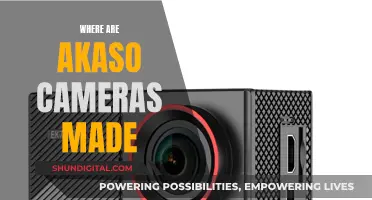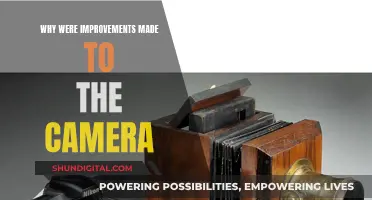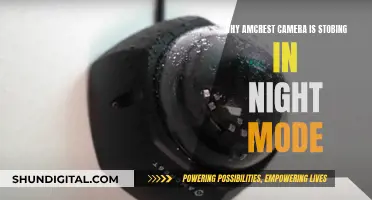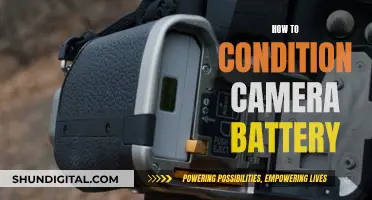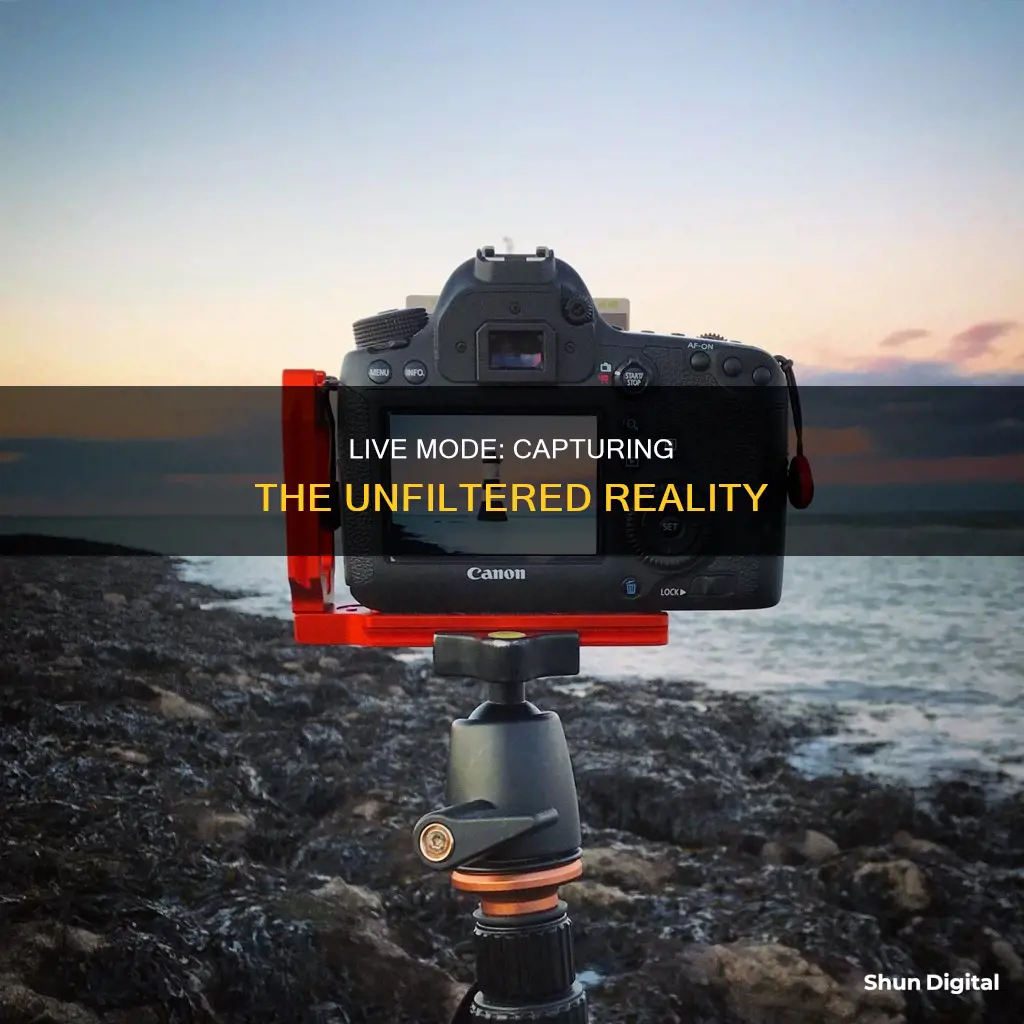
Live mode, or Live View, is a feature on many digital cameras that allows the photographer to see what the lens is seeing in almost real-time on the camera's LCD screen. This includes the effects of any changes in exposure settings. Live View is particularly useful when recording video as it allows the photographer to see a constant moving image.
| Characteristics | Values |
|---|---|
| Camera feature | Live View |
| --- | --- |
| Camera type | Digital cameras, smartphones, point-and-shoot models, bridge cameras, mirrorless cameras, and DSLRs |
| Camera components | Photographic sensor output, LCD screen, mirror, autofocus functionality, dual pixel imaging sensors, CMOS sensor |
| Camera modes | Live View mode, manual mode, Movie mode |
| Camera settings | Aperture, shutter speed, ISO, exposure settings, white balance, Picture Style setting, metering mode |
| Camera functions | Autofocus, exposure simulation, shooting aids, histogram, touch-focusing, continuous shooting speed, flash |
What You'll Learn
- Live View lets you see what the lens is seeing in real-time, including the effects of any changes in exposure settings
- Live View is available on most cameras, including smartphones, point-and-shoot models, bridge cameras, and mirrorless cameras
- Live View offers exposure simulation, so you can see how the tones of your photos will look before you press the shutter button
- Live View can be used to preview effects, such as selective colouring, miniature, black-and-white, sepia, and film simulations
- Live View lets you simulate the exposure for each image in advance, helping to prevent over- and underexposure

Live View lets you see what the lens is seeing in real-time, including the effects of any changes in exposure settings
Live View is a camera feature that allows you to see what the lens is seeing in real-time. It displays the photographic sensor output on the camera's LCD screen. This means that you can see the effects of any changes in exposure settings, such as adjusting the shutter speed, in real-time.
When using Live View, the camera's mirror is lifted, which can limit autofocus functionality in cameras with dedicated phase detection autofocus sensors. This can be overcome by using dual-pixel imaging sensors.
Live View is available on most modern digital cameras, including DSLRs, mirrorless cameras, smartphones, point-and-shoot models, bridge cameras, and more. It is particularly useful when capturing images from tricky angles, such as low-angle landscapes, or when working with tricky exposure conditions like outdoor portrait photography.
Live View also offers exposure simulation, allowing photographers to see how the tones of their photos will look before capturing the image. It provides an array of shooting aids, such as the rule of thirds grid for composition, focus peaking to identify areas in sharp focus, and a histogram to evaluate the tonal range of the image.
It's important to note that Live View may not be ideal for tracking moving subjects or handholding in low light conditions. Additionally, it can drain the camera's battery more quickly than normal, so it's recommended to have spare batteries on hand.
Charging Mini DV Cameras: A Quick Guide
You may want to see also

Live View is available on most cameras, including smartphones, point-and-shoot models, bridge cameras, and mirrorless cameras
Live View is a camera feature that allows you to see the image that the camera's photographic sensor is capturing in real-time on the camera's LCD screen. It is available on most cameras, including smartphones, point-and-shoot models, bridge cameras, and mirrorless cameras.
When using Live View, the photographer sees what the lens is seeing, including the effects of any changes in exposure settings. This can be very useful when trying to capture images from tricky angles, such as low-angle landscapes, or when working with tricky exposure conditions. It is also beneficial when you want to be certain that you have nailed your composition, or when doing long-exposure photography with a tripod.
However, Live View does come with a slight lag, and it is not ideal when tracking moving subjects, handholding in low light, or when the photographer wants to be fully immersed in a scene.
Live View is particularly useful for mirrorless cameras, as they do not have a viewfinder. All mirrorless cameras use an electronic viewfinder, which uses the imaging sensor to display an image on a small LCD or OLED screen. This is in contrast to DSLRs, which use an optical viewfinder that reflects light coming in through the lens up into the viewfinder, giving an unprocessed view.
Live View also offers a range of shooting aids, including the rule of thirds grid, focus peaking, and a histogram, which can help photographers improve their compositions and evaluate the tonal range of their images more precisely.
Understanding AE Mode: Camera's Auto Exposure Explained
You may want to see also

Live View offers exposure simulation, so you can see how the tones of your photos will look before you press the shutter button
Live View is a camera feature that allows you to see how your images will turn out before you take them. It is available on most cameras, including DSLRs, smartphones, point-and-shoot models, bridge cameras, and mirrorless cameras.
When using Live View, you can see the photographic sensor output on the camera's LCD screen in almost real-time. This means that the photographer sees what the lens is seeing, including the effects of any changes in exposure settings. Live View offers exposure simulation, allowing you to see how the tones of your photos will look before you press the shutter button. This is especially useful when working with tricky exposure conditions, as it helps ensure that you capture plenty of detail.
In addition to exposure simulation, Live View also offers an array of shooting aids, such as the rule of thirds grid for improving compositions, focus peaking for seeing the areas of the scene that are in sharp focus, and a histogram for evaluating the tonal range of your image more precisely.
It's important to note that Live View is not always the best option. It is not ideal for tracking moving subjects, handholding in low light, or when you want to immerse yourself in a scene. Additionally, Live View introduces a slight lag, whereas some viewfinders are perfectly in sync with the outside world.
Overall, Live View is a powerful photographic tool that can be very useful in certain scenarios, such as capturing images from tricky angles, ensuring you have nailed your composition, or doing long-exposure photography with a tripod. By understanding its advantages and limitations, photographers can leverage Live View to enhance their creative workflow.
Switching Camera Modes: Galaxy S7 Tips
You may want to see also

Live View can be used to preview effects, such as selective colouring, miniature, black-and-white, sepia, and film simulations
Live View is a camera feature that allows you to see what the lens is seeing through the camera's LCD screen. It is available on most cameras, including DSLRs, mirrorless cameras, smartphones, point-and-shoot models, bridge cameras, and more. Live View is particularly useful when you want to preview the effects of your photography before taking a shot.
One of the benefits of Live View is that it allows you to preview effects such as selective colouring, miniature, black-and-white, sepia, and film simulations. These effects can be applied in real-time, giving you a better understanding of how your image will turn out before you press the shutter button. This feature is similar to Instagram filters or Lightroom presets, except they are added during the shooting process rather than in post-production.
For example, by setting your camera to black-and-white mode and activating Live View, you can see your surroundings in monochrome, helping you create more compelling compositions. It is important to note that to bake these effects into the final file, you will need to shoot in JPEG format instead of RAW.
In addition to previewing effects, Live View also offers exposure simulation. This feature allows you to see exactly how the tones of your photos will look before capturing them. Live View also comes with an array of shooting aids, including the rule of thirds grid for improving compositions, focus peaking for identifying areas in sharp focus, and a histogram for evaluating the tonal range of your image more precisely.
Live View provides a different perspective compared to optical and electronic viewfinders. By allowing you to view your compositions from a distance, Live View can help you evaluate and improve your shots more effectively. Furthermore, Live View is often the easiest way to compose photos when shooting from high or low angles, especially with the articulating screens that most modern cameras offer.
While Live View offers several advantages, it is important to consider its limitations as well. Live View may not be ideal when tracking moving subjects, handholding in low light conditions, or when you want to fully immerse yourself in a scene. Additionally, using Live View can drain your camera's battery more quickly, so it is important to keep an eye on your battery levels.
In conclusion, Live View is a powerful tool that can enhance your photography experience by allowing you to preview effects, simulate exposure, and compose your shots from different angles. Experiment with Live View and adjust your approach to find what works best for your photography style.
Are PTZ Cameras Electrically Charged?
You may want to see also

Live View lets you simulate the exposure for each image in advance, helping to prevent over- and underexposure
Live View is a camera feature that allows you to see how your images will turn out before you take them by viewing the sensor's feed on the rear LCD screen. In other words, you can see what the lens is seeing, including the effects of any changes in exposure settings. This is particularly useful when you're working with tricky exposure conditions and you want to be sure you've captured enough detail, such as in outdoor portrait photography.
Live View has an exposure simulation feature, which means you can see exactly how the tones of your photos will look before you press the shutter button. This helps you to prevent over- and underexposure. You can also use the histogram to ensure a good exposure. Instead of simply glancing at the rear LCD, you can activate the Live View histogram (if your camera has this function) and check the histogram before you take each shot. Make sure there are no peaks pressed up against either side of the graph, and adjust your settings if there are.
However, Live View is not always the best option. It doesn't work well when tracking moving subjects, handholding in low light, or when you want to immerse yourself in a scene.
Extracting Raw Files: Unlocking Your Camera's Full Potential
You may want to see also
Frequently asked questions
Live Mode, or Live View, is a feature on many DSLR cameras that allows the photographer to view the photographic sensor output in almost real-time on the camera's LCD screen. This lets the photographer see what the lens is seeing, including the effects of any changes in exposure settings.
Live Mode offers exposure simulation, so you can see how the tones of your photos will look before you press the shutter button. It also comes with an array of shooting aids, including the rule of thirds grid, focus peaking, and a histogram.
Live Mode can be unsuitable for tracking moving subjects, handholding in low light, or when you want to be fully immersed in a scene. It also introduces a slight lag, whereas some viewfinders are perfectly in sync with the outside world.



